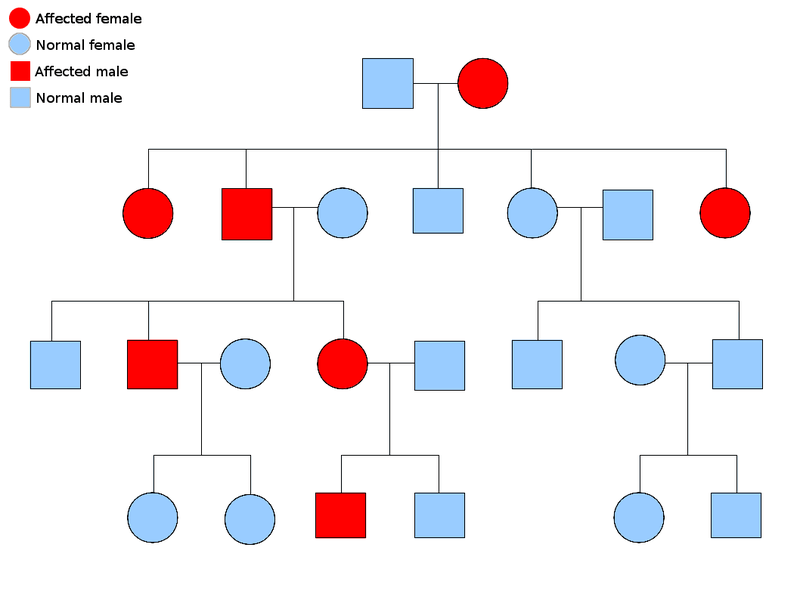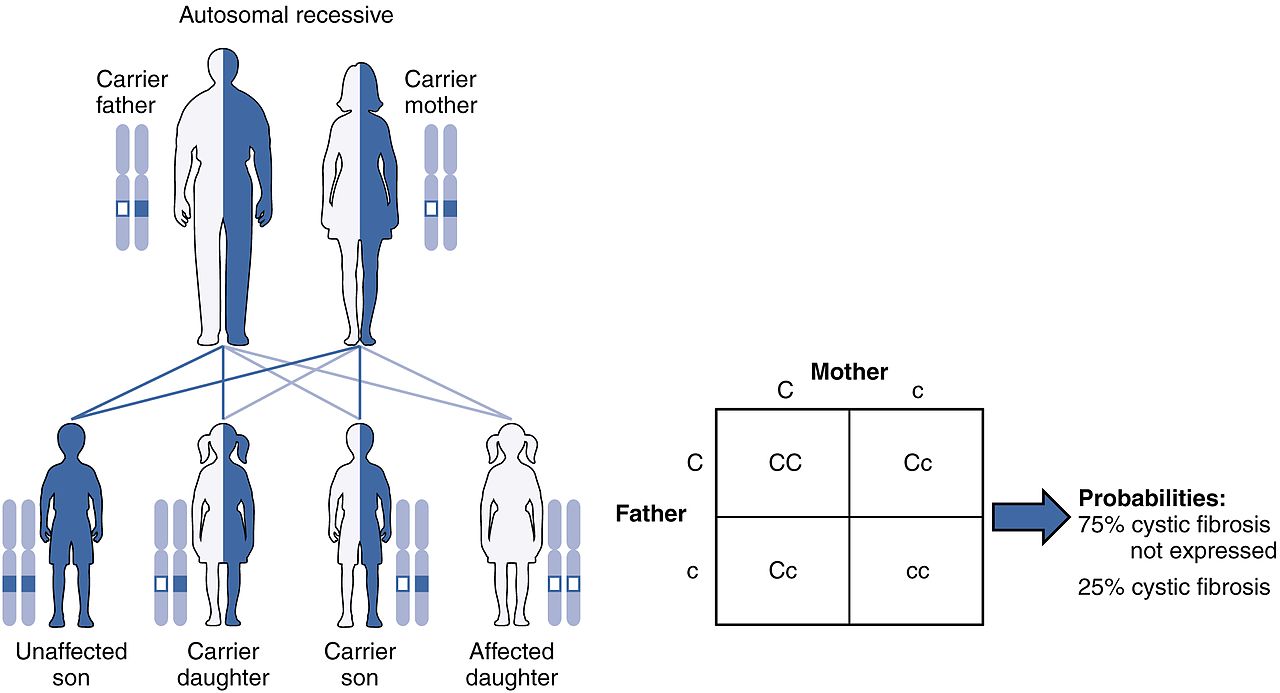The key difference between autosomal dominant and autosomal recessive disorders is that, in autosomal dominant disorders, one altered copy of a gene is enough to cause the disease while, in autosomal recessive disorders, both altered copies of the gene are needed to cause the disease.
Autosomal dominant and autosomal recessive disorders are inherited genetic disorders. In both disorders, the affected gene is present in an autosome (non-sex chromosome). In autosomal dominant condition, one altered copy of the gene in a cell is sufficient for a person to be affected by the disease. In autosomal recessive condition, both recessive copies of the gene in a cell are needed for a person to be affected.
CONTENTS
1. Overview and Key Difference
2. What are Autosomal Dominant Disorders
3. What are Autosomal Recessive Disorders
4. Similarities Between Autosomal Dominant and Autosomal Recessive Disorders
5. Side by Side Comparison – Autosomal Dominant vs Autosomal Recessive Disorders in Tabular Form
6. Summary
What are Autosomal Dominant Disorders?
In autosomal dominant condition, the mutated copy of the gene is a dominant one. This mutated copy is located on one of the non-sex chromosomes. A person needs only one mutated copy of the gene to be affected by this type of disorder. The affected person has a 50% chance of having an affected child with one mutated copy (dominant) of the gene. The same person also has a 50% chance of an unaffected child with two normal copies (recessive) of the gene. Each affected person usually has one affected parent in autosomal dominant disorders.

Figure 01: Autosomal Dominant Disorder
Autosomal dominant conditions sometimes show reduced penetrance. It means although only one copy is needed to develop the disease, not all individuals who inherit the mutation will be affected by the disease. For example, in conditions such as tuberous sclerosis, people may be minimally affected. But they have a higher risk of having severely affected children.
Autosomal dominant disorders affect both males and females. These disorders have late onset of sign and symptoms. The dominant disorder is not transmitted by unaffected family members. The popular examples of autosomal dominant disorders are Huntington disease, tuberous sclerosis, Myotonic dystrophy and neurofibromatosis.
What are Autosomal Recessive Disorders?
An autosomal recessive disorder is a genetic disorder in which two copies of an abnormal gene are responsible for the development of a disease. The recessive inheritance means both mutated copies of a gene must be abnormal (recessive) to cause the disease. The parents of a child that is suffering from an autosomal recessive disorder usually do not have the disease. These unaffected parents are carriers. The parents carry a mutated copy of the gene that can be passed to their children. The parents have a 25% chance of having an unaffected child with two normal copies of a gene, a 50% chance of having an unaffected child who is also a carrier, and a 25% chance of having an affected child with two recessive copies of a gene.

Figure 02: Autosomal Recessive Disorder
In this disorder, the affected gene is located on a non-sex chromosome. Autosomal recessive disorders are not typically observable in every generation of an affected family. Sickle cell disease and cystic fibrosis are common examples of autosomal recessive disorders.
What are the Similarities Between Autosomal Dominant and Autosomal Recessive Disorders?
- Both are genetic conditions.
- In both conditions, affected genes present on an autosome (non-sex chromosome).
- Both conditions are inherited.
- They both cause severe diseases.
What is the Difference Between Autosomal Dominant and Autosomal Recessive Disorders?
In autosomal dominant disorder, one altered copy of the gene in a cell is sufficient for a person to be affected by a disease. In contrast, in autosomal recessive condition, both copies of the gene are needed for a person to be affected by a disease. So, this is the key difference between autosomal dominant and autosomal recessive disorders. Moreover, in autosomal dominant disorders, a person with an autosomal dominant condition has a 50% chance of having an affected child with one mutated copy (dominant) of the gene. On the other hand, in autosomal recessive disorders, the unaffected parents have a 25% chance of having an affected child with both mutated copies (recessive) of the gene. Thus, this is another important difference between autosomal dominant and autosomal recessive disorders.
The below infographic shows more differences between autosomal dominant and autosomal recessive disorders in tabular form.

Summary – Autosomal Dominant vs Autosomal Recessive Disorders
In autosomal disorders, the affected gene is present on a non-sex chromosome. A single copy of the disease-associated mutation is enough to cause the disease in autosomal dominant disorder. Two copies of the disease-associated mutation are needed to cause the disease in autosomal recessive disorder. Thus, this is the key difference between autosomal dominant and autosomal recessive disorders.
Reference:
1. “Autosomal Dominant: MedlinePlus Medical Encyclopedia.” MedlinePlus, U.S. National Library of Medicine, Available here.
2. “Genetic Disorder.” Wikipedia, Wikimedia Foundation, 11 Mar. 2021, Available here.
Image Courtesy:
1. “Autosomal dominant” By Simon Caulton – Own work (CC BY-SA 3.0) via Commons Wikimedia
2. “2926 Autosomal Recessive Inheritance-new” By OpenStax College – Anatomy & Physiology, Connexions Web site, Jun 19, 2013. (CC BY 3.0) via Commons Wikimedia
ncG1vNJzZmivp6x7pbXFn5yrnZ6YsqOx07CcnqZemLyue8OinZ%2Bdopq7pLGMm5ytr5Wau26t1K2mrKedlrlusM6moKeZnql6orrDZpiurJ%2BovK6ty2apnpuVqMCqwsRmm6Krn6expr7SaA%3D%3D